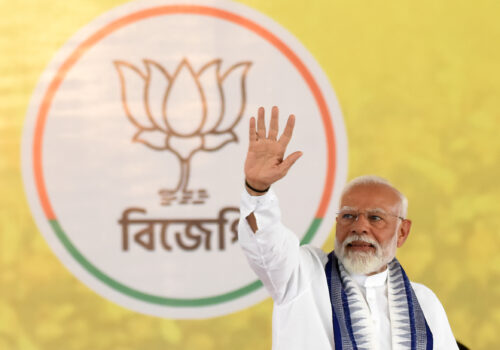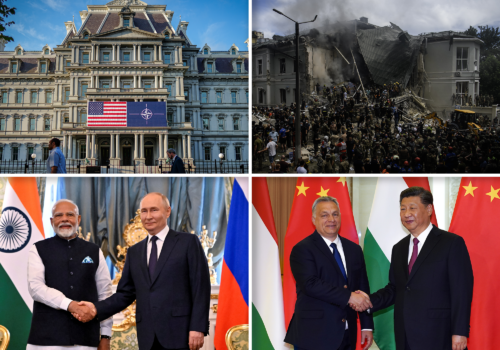The Modi-Xi fence-mending is a sign of the times
There is no danger in making too much of this week’s efforts by Indian Prime Minister Narendra Modi and Chinese leader Xi Jinping to mend fences in their first meeting in five years.
The danger would be to underestimate what that meeting says about the world that the next US president will inherit after the November elections. It is one where adversaries are likely to test a new president, allies will hedge, and a rising power like India will go its own way.
This is going to require a president with the skills to navigate a fast-changing geopolitical landscape on a three-dimensional chessboard where many of the moves will be more difficult to direct or decode.
Modi and Xi’s meeting came Wednesday in Kazan, Russia, on the sidelines of the BRICS summit, named for its core members Brazil, Russia, India, China, and South Africa. The thaw in their countries’ frosty relationship calls for more nuance in US thinking about the global landscape—and particularly about how to manage relations with India, the world’s most populous democracy.
For years, Washington has viewed most large and medium powers in the world through the prism of its own strategic ambitions. India is the mother of all swing states, so bringing it onto the US and Western side in a contest for the future of the global order could be a game changer if it weren’t so unlikely a near-term outcome.
The better approach will be to understand how India is defining its own global strategic purpose as a country whose influence will only grow in the years ahead. It will be neither pro-American nor anti-Chinese. It will act according to how it calculates its own national interests. Understanding those interests will make it easier for Washington to improve its relations with India.
Wall Street Journal reporters Austin Ramzy and Tripti Lahiri write that “for India, which has been drawing closer to the U.S. and has benefited from Washington’s rivalry with China, easing the standoff on the Himalayan border would reduce pressure on its defense budget and allow it to focus on other arenas of geopolitical competition with its neighbor—such as the Indian Ocean. It also needs to redouble its efforts to build an industrial economy.”
In 2021, I met with India’s external affairs minister and one of the world’s most perceptive geopolitical thinkers, Subrahmanyam Jaishankar. He spoke with me about an emerging period of US “strategic contraction,” after several decades of unrivaled US global leadership. He saw it as one of the four factors shaping our times.
The other three: increased Chinese relevance in almost every corner of the world; the rise of middle-sized powers with regional and international influence (India being atop that list); and the evolution of new, interest-based “shareholder groups,” such as the BRICS group. They won’t supplant existing alliances but will complement them.
Going forward, Jaishankar said, the United States “will still be the premier power by a large margin, but one more realistic and open to working with others. . . . The contraction actually helps create a transitional order” from the Cold War period, past the post-Cold War era of US dominance, to a new geopolitical configuration.
As Modi and Xi were meeting in Kazan, Russian President Vladimir Putin was boasting about a “new world order.” In the emerging geopolitical era, Putin wants US strategic contraction to mean a weaker, less relevant United States. It will fall on the shoulders of whichever candidate is elected on November 5 to make sure that is not the case.
Frederick Kempe is president and chief executive officer of the Atlantic Council. You can follow him on X: @FredKempe.
This edition is part of Frederick Kempe’s Inflection Points newsletter, a column of dispatches from a world in transition. To receive this newsletter throughout the week, sign up here.
Further reading
Sun, Nov 21, 2021
With the US in ‘strategic contraction,’ allies take a new approach to partnership
Inflection Points By Frederick Kempe
What our partners see now is a less externally confident, more internally focused United States guided by a sober calculation of its leverage and resources, burdened by public weariness with the cost of international leadership and hobbled by domestic political polarization.
Wed, May 29, 2024
What India and the world could expect from a Modi 3.0
New Atlanticist By Gopal Nadadur
If victorious in this year’s elections, Modi will likely prioritize economic reforms, infrastructure, and growing India’s global profile.
Tue, Jul 9, 2024
Putin, Xi, Orbán, and Modi provide a disturbing backdrop to the start of the NATO Summit
Inflection Points Today By Frederick Kempe
The split screens haunting the NATO Summit include a deadly attack on a children’s hospital and meetings with autocrats in Moscow and Beijing.
Image: Chinese President Xi Jinping and India Prime Minister Narendra Modi meet on the sidelines of the BRICS summit in Kazan, Russia October 23, 2024. China Daily via REUTERS


